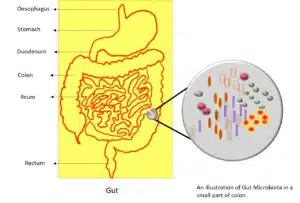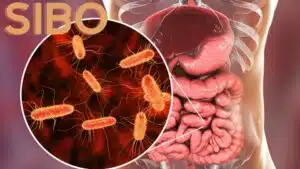We have all heard of Probiotics, Prebiotics, and even Synbiotics. But what are postbiotics? How are they different from probiotics? Can we go beyond probiotics and take a postbiotic supplement for our gut health?
The Problem With Our Microbiome
Within our digestive system, we house an entire ecosystem of “good bugs” that keeps our bodies metabolically balanced. However, certain lifestyle habits can disrupt this delicate equilibrium among our gut florae. Factors such as a diet high in ultra-processed foods, lack of exercise or movement, poor stress management, certain medications, and insufficient sleep can all negatively impact our gut health.
To counteract these disruptions and support a healthy gut, many people are turning to probiotics and postbiotics as additional sources alongside adopting healthy lifestyle habits. Here in this article, we will primarily focus on postbiotics. We will define what postbiotics are, explore their benefits, identify natural and supplemental sources of postbiotics, as well as provide a summary of the current research findings.
What is a POSTbiotic?
Postbiotics contain bacterial strains that have been rendered non-living through processes like heat exposure and high pressure, extracting valuable byproducts that have positive effects on our body’s microbiome activity. These byproducts include short-chain fatty acids (SCFA), carbohydrate enzymes, polyphenols, vitamins B and K, and antimicrobial peptides. (1) Without these vital compounds, the integrity of our immune system and digestive health can be compromised, as well as increasing our susceptibility to infections. (2)
Fermented foods serve as a natural source of postbiotics since they come packaged with non-living microbes, metabolites, and fibers all functioning to support optimal health in our microbiome. Examples of fermented foods include sourdough bread, yogurt, cottage cheese, miso, pickled vegetables, Sauerkraut, kefir, tempeh, and kimchi. By consuming these fermented foods, we introduce a variety of postbiotic compounds into our diet, supporting a diverse and high-functioning microbiome.
There is a common misconception that postbiotics are simply expired or inactive forms of probiotics, but this is not always the case. The key criterion for a substance to be considered a postbiotic is that it results from the metabolic activity of microorganisms, whether living or non-living. So, even if the bacterium undergoes a process to deactivate its viable activity through methods like heat or high pressure, the resulting inactive bacterial content and its cellular components qualify as postbiotics. (1)
Are Postbiotics a Newfound Discovery?
The concept of postbiotics itself is not a new area of research; however, the term “postbiotics” has been recently defined by the International Scientific Association for Prebiotics and Probiotics (ISAPP) to minimize confusion in scientific literature. As more studies are conducted and published on this topic, it is common to encounter the interchangeable use of terms such as “para-probiotics”, “heat-killed probiotics”, and/or “nonviable probiotics”. (1) This reflects the evolving understanding and terminology within the field.
Postbiotics are a growing interest in research due to their extended shelf life and perceived superior safety profile as compared to probiotics. Remember that probiotics contain living bacterial strains, making them sensitive to temperature and oxygen exposure, which can compromise their viability. Whereas postbiotics contain non-living bacteria, making them highly resistant to environmental factors and temperature variations during storage. Also, postbiotics presumably have a better safety profile since non-living bacteria can’t replicate to cause bacteremia, albeit this scenario is extremely rare when consuming probiotics. (3)
What does the research say about postbiotic effectiveness?
Several small clinical studies have been conducted using specific heat-killed bacteria as a postbiotic treatment for various conditions including diarrhea, obesity, common colds, eczema, irritable bowel syndrome, Chron’s disease, and diverticulitis. In studies focusing on the frequency of diarrhea episodes, there were significant reductions in daily bowel movements and symptom improvement. Additionally, studies investigating body fat mass and waist circumference found that after three months of postbiotic consumption, there was only a slight decrease in waist circumference ranging from ¾ of an inch to 1.1 inches. Another study found that after consuming a postbiotic for 20 weeks decreased the incidence of the common cold, potentially due to increased activity of immunoglobulin A activity, which serves as the first line of defense against infections. (4)
Indeed, there are certain challenges when reviewing clinical studies to determine when a postbiotic treatment is appropriately needed. One of the challenges is the inconsistency among the types of heat-killed bacteria used for specific disease states assessed. This variability makes it difficult to determine whether the observed results are directly attributed to the postbiotic used or if they are influenced by other compounds present in the intervention such as prebiotics and probiotics. Additionally, the quantity of nonviable bacteria used varies significantly among studies, making it challenging to establish an optimal dose for showing improvements in disease states. These are just a few factors among many that contribute to the complexity of interpreting and comparing the findings of different postbiotic studies.
Can I find Postbiotics as a Supplement?
Postbiotic supplements can be found in combination with other health-promoting ingredients and as standalone options. Most commonly, postbiotic supplements on the market are combined with prebiotics and postbiotics. The combination of these three sources can serve as a powerful approach to enhance the body’s microbiome activity, promoting immune and gut health. However, finding standalone postbiotic supplements can be challenging. Instead, you may come across products that are marketed with unique ingredients claiming to have postbiotic effects. Examples of such ingredients include butyrate and tributyrin.
Butyrate is a short-chain fatty acid that is naturally produced by beneficial bacteria in the colon through the fermentation of complex carbohydrate food sources. Among postbiotic supplements, you may find butyrate labeled in different forms such as tributyrin or sodium butyrate. For those suffering from digestive complications, consuming an exogenous source of butyrate has been shown to decrease the severity of these symptoms. (5) This compound also plays a vital role in strengthening our immune system, regulating body weight, maintaining stable blood sugar levels as well as supporting the integrity of our intestinal wall. Since butyrate is a well-established byproduct of microbiome activity, it is logical to classify this compound as a postbiotic. (6)(7)
On the other hand, tributyrin is the triglyceride form of butyrate. For every one molecule of tributyrin, there are three molecules of butyrate. Some supplement companies claim that converting butyrate into its triglyceride form enhances the bioavailability of butyrate. This means consuming butyrate in its triglyceride form allows it to bypass the harsh environment of stomach acid and prevent premature breakdown before reaching the small intestine. Once in the small intestine, lipase enzymes begin their work to release butyrate molecules from tributyrin, making butyrate available to be absorbed in both small and large intestines. (7-10)
Does this imply supplements listing sodium butyrate as their active ingredient are not well absorbed? Not necessarily. The concern regarding the consumption of butyrate in the salt form is that when taken orally, a significant portion of butyrate is absorbed in the upper gastrointestinal (GI) tract (small intestine), limiting its availability to be absorbed in the large intestine. Therefore, some supplement companies have formulated their sodium butyrate products to be enteric-coated. By utilizing this formulation, the breakdown of sodium butyrate is delayed until it reaches the small and large intestines; thereby increasing butyrate’s availability to be absorbed. (7)
An animal study compared the absorption between tributyrin (triglyceride form) and enteric-coated sodium butyrate. The findings suggested that the triglyceride form exhibited more beneficial effects compared to its salt form due to increased bioavailability. However, it is important to note that further human studies are required to validate and replicate these results. (9)
Currently, there is no conclusive evidence to determine which supplemental form of postbiotic butyrate, whether in combination with pre/probiotics, sodium butyrate, or tributyrin, is the most effective. The choice of which form to consume may depend on factors such as price, availability, as well as personalized recommendations from a healthcare professional.
Due to limited evidence, it may be beneficial to focus on getting postbiotic sources through a well-balanced diet consisting of fermented foods, and fiber-rich foods like fruits and vegetables. This approach is supported well by evidence to provide a diverse array of naturally sourced postbiotics for optimal wellbeing.
Final Recommendations
In conclusion, postbiotics are an area of ongoing research due to their promising health benefits, particularly in the realms of the immune system and digestive health. Since current research is limited and inconsistent, it is crucial to consult a physician to determine if a postbiotic supplement is even needed or if obtaining postbiotics naturally from food sources would be sufficient to reap gut health benefits. When the decision is made to purchase a postbiotic supplement, keep in mind there is not enough evidence to support choosing one formulation over the other. Factors such as price, availability, and professional recommendations from a doctor or pharmacist play a vital role in choosing the best supplement for you.
Sources
- ISAPP. Behind the publication: Understanding ISAPP’s new scientific consensus definition of postbiotics. Published May 5th, 2021. https://isappscience.org/behind-thepublication-understanding-isapps-new-scientific-consensus-definition-of-postbiotics/ (Accessed July 10, 2023).
- Vinderola G., Sanders M.E., Salminen S. The Concept of Postbiotics. National Library of Medicine: Foods. 2022; 11,1077:1-10. https://www.ncbi.nlm.nih.gov/pmc/articles/PMC9027423/
- Salminen, S., Collado, M.C., Endo, A. et al. The International Scientific Association of Probiotics and Prebiotics (ISAPP) consensus statement on the definition and scope of postbiotics. Nat Rev Gastroenterol Hepatol. 2021; 18:649–667 https://www.nature.com/articles/s41575-021-00440-6
- ConsumerLab. Probiotic Supplement Review (including Pet Probiotics). All About Postbiotics. Published November 2022. https://www.consumerlab.com/reviews/probioticsupplements/probiotics/#postbiotics (Accessed July 11, 2023).
- Liu H., Wang J., He T., et al. Butyrate: A double-edged sword for health? Adv Nutr. 2018;(1): 21–29. https://www.ncbi.nlm.nih.gov/pmc/articles/PMC6333934/
- Portincasa P, Bonfrate L, Vacca M, et al. Gut Microbiota and Short Chain Fatty Acids: Implications in Glucose Homeostasis. Int J Mol Sci. 2022;23(3):1105 https://www.ncbi.nlm.nih.gov/pmc/articles/PMC8835596/
- ConsumerLab. Butyrate supplements for gut health: does butyric acid really work and is it safe? Published April 17, 2023. https://www.consumerlab.com/answers/butyratesupplements-for-gut-health/butyrate-supplements/?search=butyrate (Accessed July 12, 2023).
- National Center for Biotechnology Information. PubChem Compound Summary for CID 6050, Tributyrin. https://pubchem.ncbi.nlm.nih.gov/compound/Tributyrin (Accessed July 13, 2023).
- Xiong, J., Qiu H., Bi Y. et al. Effects of Dietary Supplementation with Tributyrin and Coated Sodium Butyrate on Intestinal Morphology, Disaccharidase Activity and Intramuscular Fat of Lipopolysaccharide- Challenged Broilers. Brazilian Journal of Poultry Science. 2018; 20(4):707-716. https://www.scielo.br/j/rbca/a/LLZMDtQQ4QvdzqwpDGkcw4t/?format=pdf&lang=en
- Compound Solutions Inc. What are the benefits of tributyrin? Published September 7th, https://compoundsolutions.com/benefits-of-tributyrin/#pharmacokinetic-studyunpublished-2020-edelman-et-al-2003-hamer-et-al-2010-topping-et-al-2001-sauer-et-al-2007-pituch-et-al-2013-canfora-et-al-2015-seganfredo-et-al-2017 (Accessed July 11, 2023).

Amanda Prohaska
Related Posts

Synbiotic, Prebiotic, Probiotic – Take Care Of Your Gut
What is Gut Microbiota? Why do we have Gut Microbiota? What is Dysbiosis? What are dysbiosis symptoms? What causes dysbiosis? How to maintain a healthy

Symptoms of SIBO vs IBS, hydrogen vs methane SIBO symptoms and Hydrogen sulfide SIBO
SIBO – the real cause of your bloating and how to get rid of it? SIBO stands for Small Intestinal Bacterial Overgrowth and is one

How To Have A Happy Gut For A Happy You!
Food And Mood Connection and the happiness gut connection – Did you know that happy foods lead to happy moods via a happy gut? Mental

Kefir Grains Make The Milk Better
What is Kefir? Or Milk Kefir? Kefir is a type of fermented milk drink that is made from kefir grains. The milk kefir drink

Colon Broom Reviews, Ingredients, Side effects
Colon broom is a popular natural, plant-based, dietary fiber health supplement that has gained a lot of attention in recent years for improving gut health.

Provitalize Reviews, Ingredients, Side Effects – Does This Thermogenic Probiotic Work?
What are thermogenic probiotics? Is Provitalize a thermogenic probiotic? Does Provitalize Thermogenic Probiotic work in against dysbiosis in menopause and improve overall health and wellness?

